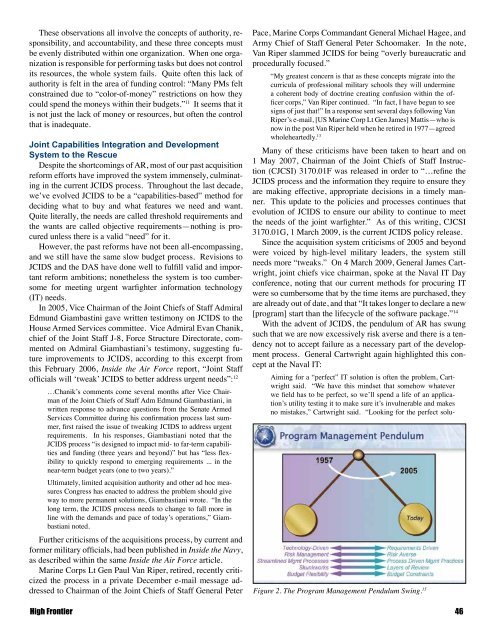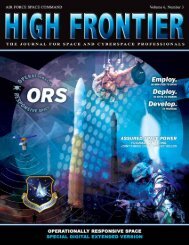Space Acquisition - Air Force Space Command
Space Acquisition - Air Force Space Command
Space Acquisition - Air Force Space Command
You also want an ePaper? Increase the reach of your titles
YUMPU automatically turns print PDFs into web optimized ePapers that Google loves.
These observations all involve the concepts of authority, responsibility,<br />
and accountability, and these three concepts must<br />
be evenly distributed within one organization. When one organization<br />
is responsible for performing tasks but does not control<br />
its resources, the whole system fails. Quite often this lack of<br />
authority is felt in the area of funding control: “Many PMs felt<br />
constrained due to “color-of-money” restrictions on how they<br />
could spend the moneys within their budgets.” 11 It seems that it<br />
is not just the lack of money or resources, but often the control<br />
that is inadequate.<br />
Joint Capabilities Integration and Development<br />
System to the Rescue<br />
Despite the shortcomings of AR, most of our past acquisition<br />
reform efforts have improved the system immensely, culminating<br />
in the current JCIDS process. Throughout the last decade,<br />
we’ve evolved JCIDS to be a “capabilities-based” method for<br />
deciding what to buy and what features we need and want.<br />
Quite literally, the needs are called threshold requirements and<br />
the wants are called objective requirements—nothing is procured<br />
unless there is a valid “need” for it.<br />
However, the past reforms have not been all-encompassing,<br />
and we still have the same slow budget process. Revisions to<br />
JCIDS and the DAS have done well to fulfill valid and important<br />
reform ambitions; nonetheless the system is too cumbersome<br />
for meeting urgent warfighter information technology<br />
(IT) needs.<br />
In 2005, Vice Chairman of the Joint Chiefs of Staff Admiral<br />
Edmund Giambastini gave written testimony on JCIDS to the<br />
House Armed Services committee. Vice Admiral Evan Chanik,<br />
chief of the Joint Staff J-8, <strong>Force</strong> Structure Directorate, commented<br />
on Admiral Giambastiani’s testimony, suggesting future<br />
improvements to JCIDS, according to this excerpt from<br />
this February 2006, Inside the <strong>Air</strong> <strong>Force</strong> report, “Joint Staff<br />
officials will ‘tweak’ JCIDS to better address urgent needs”: 12<br />
…Chanik’s comments come several months after Vice Chairman<br />
of the Joint Chiefs of Staff Adm Edmund Giambastiani, in<br />
written response to advance questions from the Senate Armed<br />
Services Committee during his confirmation process last summer,<br />
first raised the issue of tweaking JCIDS to address urgent<br />
requirements. In his responses, Giambastiani noted that the<br />
JCIDS process “is designed to impact mid- to far-term capabilities<br />
and funding (three years and beyond)” but has “less flexibility<br />
to quickly respond to emerging requirements ... in the<br />
near-term budget years (one to two years).”<br />
Ultimately, limited acquisition authority and other ad hoc measures<br />
Congress has enacted to address the problem should give<br />
way to more permanent solutions, Giambastiani wrote. “In the<br />
long term, the JCIDS process needs to change to fall more in<br />
line with the demands and pace of today’s operations,” Giambastiani<br />
noted.<br />
Further criticisms of the acquisitions process, by current and<br />
former military officials, had been published in Inside the Navy,<br />
as described within the same Inside the <strong>Air</strong> <strong>Force</strong> article.<br />
Marine Corps Lt Gen Paul Van Riper, retired, recently criticized<br />
the process in a private December e-mail message addressed<br />
to Chairman of the Joint Chiefs of Staff General Peter<br />
Pace, Marine Corps <strong>Command</strong>ant General Michael Hagee, and<br />
Army Chief of Staff General Peter Schoomaker. In the note,<br />
Van Riper slammed JCIDS for being “overly bureaucratic and<br />
procedurally focused.”<br />
“My greatest concern is that as these concepts migrate into the<br />
curricula of professional military schools they will undermine<br />
a coherent body of doctrine creating confusion within the officer<br />
corps,” Van Riper continued. “In fact, I have begun to see<br />
signs of just that!” In a response sent several days following Van<br />
Riper’s e-mail, [US Marine Corp Lt Gen James] Mattis—who is<br />
now in the post Van Riper held when he retired in 1977—agreed<br />
wholeheartedly. 13<br />
Many of these criticisms have been taken to heart and on<br />
1 May 2007, Chairman of the Joint Chiefs of Staff Instruction<br />
(CJCSI) 3170.01F was released in order to “…refine the<br />
JCIDS process and the information they require to ensure they<br />
are making effective, appropriate decisions in a timely manner.<br />
This update to the policies and processes continues that<br />
evolution of JCIDS to ensure our ability to continue to meet<br />
the needs of the joint warfighter.” As of this writing, CJCSI<br />
3170.01G, 1 March 2009, is the current JCIDS policy release.<br />
Since the acquisition system criticisms of 2005 and beyond<br />
were voiced by high-level military leaders, the system still<br />
needs more “tweaks.” On 4 March 2009, General James Cartwright,<br />
joint chiefs vice chairman, spoke at the Naval IT Day<br />
conference, noting that our current methods for procuring IT<br />
were so cumbersome that by the time items are purchased, they<br />
are already out of date, and that “It takes longer to declare a new<br />
[program] start than the lifecycle of the software package.” 14<br />
With the advent of JCIDS, the pendulum of AR has swung<br />
such that we are now excessively risk averse and there is a tendency<br />
not to accept failure as a necessary part of the development<br />
process. General Cartwright again highlighted this concept<br />
at the Naval IT:<br />
Aiming for a “perfect” IT solution is often the problem, Cartwright<br />
said. “We have this mindset that somehow whatever<br />
we field has to be perfect, so we’ll spend a life of an application’s<br />
utility testing it to make sure it’s invulnerable and makes<br />
no mistakes,” Cartwright said. “Looking for the perfect solu-<br />
Figure 2. The Program Management Pendulum Swing. 15<br />
High Frontier 46











